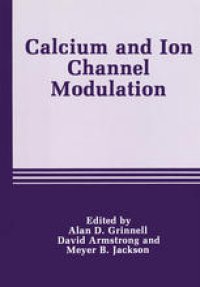
Ebook: Calcium and Ion Channel Modulation
- Tags: Science general
- Year: 1988
- Publisher: Springer US
- Edition: 1
- Language: English
- pdf
Cellular neurobiology has been transformed in the past decade by new technologies and fundamental discoveries. One result is an enormous increase in our understanding of how ion channels function in nerve and muscle cells and a widening perspective on the role of ion channels in non-neuronal cell physiology and development. Patch clamp techniques now permit direct observation of the transitions between functional confor mations of individual ion channels in their native membrane. Recombinant DNA techniques are being used to determine the primary structure of ion channel proteins and to test hypotheses about channel conformations, sites of grating and modulation, and the basis of ion selectivity. At the same time, biochemical techniques have revealed intricate signalling systems in side cells, involving second messengers such as calcium, phospholipids and cyclic nucleotides, which interface with the external milieu through GTP binding proteins and regulate cell metabolism by altering protein phos phorylation. This panorama of second messenger systems has greatly increas ed our application for their potential role in regulating ion channel function. We now recognize that ion channels are much more complicated than we once thought, and more interesting. They are not simply isolated macro molecules in the membrane, gated directly by depolarization or trans mitter binding to open briefly at a fixed conductance and then close or inactivate. Instead, individual channels now appear to have many open and closed states that are regulated independently by voltage and transmitters.
I. Voltage-Activated Calcium Channels.- Calcium Channel Diversity.- Multiple Types of Calcium Channels: Is their Function Related to Their Localization?.- Calcium Channels Incorporated Into Planar Lipid Bilayers: Phenomenology, Pharmacology, and Phylogeny.- Modulation of Ionic Selectivity of Ca Channels in the Neuronal Membrane by Ca2+ Ions..- Proton-Induced Transformation of Ca2+ Channel in Dorsal Root Ganglion Neurons..- Physiology of Multiple Calcium Channels..- Expression of Presynaptic Calcium Channels in Xenopus Oocytes..- II. Intracellular Calcium and Cell Function: Sensory Transduction, Modulation of Excitability and Neurosecretion.- Control of Light Emitting Photoprotein by Calcium Channels in a Hydrozoan Coelenterate.- Calcium in Photoreceptors..- Small Conductance Ca2+ Activated K Channels in Mollusks..- Ca2+ Diffusion in the Cytoplasm of Aplysia Neurons: Its Relationship to Local Concentration Changes..- Fura-2 Imaging of Localized Calcium Accumulation Within Squid ‘Giant’ Presynaptic Terminal.- Toward a Molecular Understanding of Synaptic Transmitter Release: Physiological Clues from the Squid Giant Synapse..- Quantal Classes and Subunits of Quanta in the Neuromuscular Junction.- III. Ion Channel Modulation by Neurotransmitters and Second Messengers.- Cytoplasmic Modulation of Ion Channel Functioning in the Neuronal Membrane..- Control of the Generation and Removal of Calcium-Mediated Inactivation of the Calcium Current in Helix aspersa Neurons..- The Role of Protein Phosphorylation in the Response of Dihydropyridine-Sensitive Calcium Channels to Membrane Depolarization in Mammalian Pituitary Tumor Cells..- Modulation of the Potassium Conductance in the Squid Giant Axon..- Physiological Interaction Between Calcium and Cyclip AMP in an Aplysia Bursting Pacemaker Neuron..- Functional Implications of Calcium Channel Modulation in Embryonic Dorsal Root Ganglion Neurons..- Neurotransmitter Modulation of Calcium Currents in Rat Sensory Neurons..- Modulation of Potassium and Calcium Currents by FMRFamide in Aplysia Neurons: A Mechanism of Presynaptic Inhibition.- Cytoplasmic Modulation of Transmitter Gated K Channels in Cultured Mammalian Central Neurons.- IV. Ion Channels as Causes and Consequences of Development.- Regulation of Cortical Vesicle Exocytosis in Sea Urchin Eggs..- Studies on the Development of Voltage-Activated Calcium Channels in Vertebrate Neurons..- Generation of Neuronal Architecture: Ionic Regulation of Growth Cone Behavior..- Target Cell Contact Modulates Spontaneous Quantal and Non-quantal Acetylcholine Release by Xenopus Spinal Neurons.- Development and Regulation of Acetylcholine Receptor Function.- Steroidal Regulation of mRNA Coding for Potassium Channels in Uterine Smooth Muscle..- V. New Approaches to Ion Channel Function and Regulation.- Fast Patch-Pipette Internal Perfusion with Minimum Solution Flow.- Evidence for a Bicarbonate Conductance in Neuroglia.- Divalent Cations as Modulators of NMDA-Receptor Channels on Mouse Central Neurons..- Fluorescence Imaging Applied to the Measurement of Ca2+ in Mammalian Neurons..- Use of Fused Synaptosomes or Synaptic Vesicles to Study Ion Channels Involved in Neurotransmission..- Ion Channels of Three Microbes: Paramecium, Yeast and Escherichia coli.